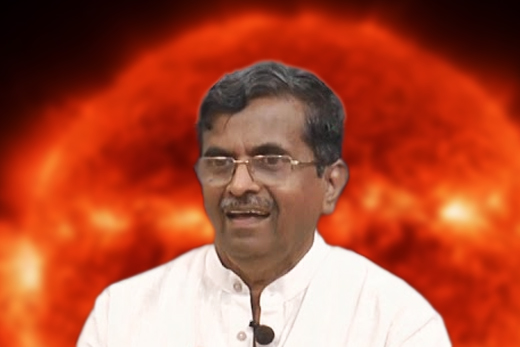Solar Activity Behind Rising Natural Disasters, Says Astronomer Dr. A.P. Bhat
Solar Activity Behind Rising Natural Disasters, Says Astronomer Dr. A.P. Bhat
Mangalore Today News Network
Udupi, Oct 25, 2026: The increasing frequency of natural disasters across the globe is linked to heightened solar activity known as the sunspot cycle, which has surpassed scientific predictions, said noted astronomer and retired principal Dr. A.P. Bhat from Udupi.
Dr. Bhat explained that phenomena such as earthquakes, volcanic eruptions, recurring cyclones, prolonged monsoons, heavy rainfall and cloudbursts are believed to be influenced by the Sun’s intensified activity.

He pointed out that the ongoing 25th 11-year sunspot cycle has gone beyond expectations. “Scientists had predicted this phase would end by January 2025, but instead, the Sun continues to release increasingly powerful solar flares - some of the strongest in a century - known as coronal mass ejections (CMEs),” he said.
Citing current weather patterns, Dr. Bhat noted that during this year’s Kartika Deepotsava season, two cyclones formed simultaneously - one in the Bay of Bengal and another in the Indian Ocean, moving toward India’s west coast. “While cyclones in the Bay of Bengal are common at this time of year, their occurrence in the Arabian Sea is unusual,” he observed.
He said such events, once rare, are now becoming an annual occurrence. “There was a time when cyclones on India’s west coast were unheard of, but things have changed. Fortunately, the Western Ghats act as a barrier, diverting these storms toward Mumbai and Gujarat,” he added.
On global seismic activity, Dr. Bhat referred to the Ring of Fire - a tectonically active belt stretching from the eastern coast of Australia through Japan, China, and Russia, across Alaska to Canada and South America - which has witnessed an increase in earthquakes this year. “This zone lies on tectonic plates about 50 km thick. When these plates collide or shift, earthquakes occur. Volcanic eruptions release streams of high-energy particles, and underwater collisions can generate tsunamis,” he explained.
Scientists, he said, believe that fluctuations in solar activity may be connected to such Earthly events. “When sunspot activity intensifies, seismic activity also increases — and the Sun is currently in a highly active phase,” he stated.
Dr. Bhat also drew attention to the growing number of cloudbursts in recent years. “Earlier, such incidents were confined to the Himalayan foothills, but now they’re occurring even in southern India. For instance, areas like Kushalnagar and Shiradi Ghat experience heavy downpours in narrow stretches, while nearby regions remain dry — a puzzling trend,” he said.
He concluded by noting that volcanic eruptions eject particles that travel vast distances, forming clusters that concentrate clouds and trigger cloudbursts. “In this grand cosmic drama, the Sun is the choreographer, and the Earth is the performer,” Dr. Bhat remarked.
- Tejashwi Yadav Big Poll Promise For Panchayat Heads with Pension, Insurance and Allowances
- Indore: Two Australian Women Cricketers Molested, Suspect Arrested
- Rohit Sharma, Virat Kohli steal the show as India defeat Australia in 3rd ODI
- Bengaluru: Poultry farmer arrested for shooting son in drunken brawl
- Bengaluru cab driver skips toll route, then assaults woman passenger, arrested
- Fire breaks out in Amritsar-Purnia Jan Sewa Express near Sonbarsha
- SIT team probing Sabarimala gold theft recovers items from jeweller: Report
- Kannada actor Divya Suresh identified as driver in Bengaluru hit-and-run
- Delhi police bust ISIS module, arrest two suspected terrorists planning suicide attacks
- "Was raped by cop 4 times": Maharashtra woman doctor’s suicide note on hand
- Mysuru farmhouse raided, four held for sex-determination test
- Journalist hacked to death in Prayagraj, accused arrested after encounter
- Solar Activity Behind Rising Natural Disasters, Says Astronomer Dr. A.P. Bhat
- Villagers Protest Against Power Line Work Damaging Farmland in Thenkamijaru
- Surathkal stabbing incident: Prime accused Gururaj arrested
- Eminent Businessman Kasturi Prabhakar Pai Passes Away
- Maruti Suzuki ‘Victoris’ Launched at Bharat Auto Cars
- Dharmasthala: SIT summons Thimarodi, Mattannavar and two others for inquiry on Oct 27
- Sullia: Man defrauded of Rs 2.9 lakh in cryptocurrency investment scam
- ’Vedic Inspirations’ art exhibition by Prof. Dr. Akhter Husain inaugurated in Mangaluru
- Bantwal: Young man killed as car crashes into divider
- Puttur illegal cattle transport case: Charge memo issued to inspector
- Mangaluru-Thiruvananthapuram direct flights to begin Oct 27; travel time cut to just 80 minutes
- Surathkal: Youth stabbed near bar; three accused and one who sheltered them arrested
- Veteran Yakshagana artiste Sujana Sullia passes away
- APD Foundation Joins WHO Civil Society Commission
- Daiva’s prediction comes true: Janardhan Reddy walks free from jail
- Skills and Competencies Take Center Stage at MSN Dialogue Series
- Court remands Maoist Lakshmi to six-day police custody
- Sandhya Shenoy honored with Society for Materials Chemistry Medal-2024
- White Cornus Apartment in Mangaluru
- City girl wins first place in state-level spell bee competition
- Alleged ‘Love Jihad’ Case in Mangaluru: Woman left home voluntarily, says police
- Girl fatally struck by reckless two-wheeler near Belman
- New residential complex for the judges inaugurated in Mangaluru
- Absconding accused nabbed after 8 years
- Truck with cylinders turns turtle in Beltangady
- Bhoota Kola artist dies of cardiac arrest
- Development of the country should be our goal: Ganesh Karnik
- Container truck gets stuck under Modankap railway bridge
- CITY INFORMATION
- TRAVEL
- TOURIST INFORMATION
- HEALTH CARE
- MISCELLANEOUS




 Write Comment
Write Comment E-Mail
E-Mail Facebook
Facebook Twitter
Twitter  Print
Print 

